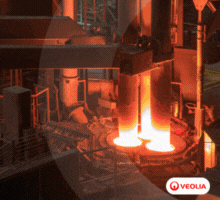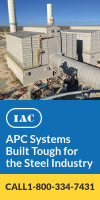Stelco CEO Says Parties Must Cooperate for Successful Restructuring
04/23/2004 -
| Return to Steel News Headlines| Print This Page |
Stelco CEO Says Parties Must Cooperate for Successful Restructuring
April 23, 2004 — Stelco Inc. President and CEO Courtney Pratt told an audience that it's time for all parties to get down to business if the restructuring of Stelco is to proceed and the company is to survive. His comments were part of a message delivered today to a luncheon meeting of the Empire Club of Canada.
An uncompetitive cost structure—plus the fact Stelco would run out of money later this year if it did not act—meant that this restructuring had to be initiated if the company is to survive. "Our problem lies in our cost structure, not in our business,” says Courtney Pratt, Stelco’s President and CEO. “We have some world-class facilities, products that are valued by the marketplace, a skilled workforce, and plans to invest the capital that will make us more competitive. “If everyone at the table works together and wants it to happen, we can achieve a positive outcome." |
Pratt noted that Stelco had initiated its Court-supervised restructuring process three months ago under the Companies' Creditors Arrangement Act (CCAA) in order to address the company's problems, protect groups that depend on it, develop a restructuring plan and once again become a viable steel producer.
"Our new senior management team took office in January," Pratt noted. "We took on these new responsibilities in order to rebuild this great company, not wind it up. Our new team is dedicated to doing that by improving the relationship with our employees, reducing our overall cost structure, improving productivity, focusing on key operations and products, and becoming more competitive.
"Our goal is a viable Stelco that can continue to provide good and well-paying jobs to its employees, security to its retirees, and a range of economic and other benefits to the communities in which it operates." Pratt added that other steel companies that have emerged successfully from their own restructuring procedures are lean, focused and operate with much lower overall cost structures, giving them a distinct competitive advantage in the marketplace. He also noted that the atmosphere of mistrust that has developed over the years between Stelco management and its employees must also be addressed if the restructuring is to proceed.
"My colleagues and I are working hard to address these intangible concerns and to instill a new culture of open communication within the company. Our challenge is to change the culture and dispel the mistrust that developed over many years in a matter of months, because the time period in which the CCAA process is conducted is not unlimited.
"In our case, it's crucial that substantive discussions begin and begin soon. We don't have the luxury of time given the problems we face and the work that has to be done if we are to develop a restructuring plan in the time available to us. Every interested group will be invited to participate in that process and we hope they all will take part. But that process will proceed because it must if Stelco is to survive," Pratt said.
An uncompetitive cost structure, plus the fact Stelco would run out of money later this year if it did not act, meant that this restructuring had to be initiated if the company is to survive. "Our problem lies in our cost structure, not in our business. We have some world-class facilities, products that are valued by the marketplace, a skilled workforce, and plans to invest the capital that will make us more competitive. If everyone at the table works together and wants it to happen, we can achieve a positive outcome," Pratt stated.
Pratt noted that failure is not an option and that all parties involved must succeed in making Stelco a viable and competitive steel producer. At risk are thousands of direct and indirect jobs in Ontario and elsewhere, significant economic activity across Canada, and considerable tax revenue for each level of government.
Pratt placed Stelco's own restructuring in the context of a vibrant and changing steel industry. He noted that the steel industry remains indispensable because it is essential to the construction, transportation, appliance, machinery, and other industries. It is a major part of the Canadian economy, representing $11 billion a year in sales and 150,000 direct and indirect jobs.
Steel is also a $500-billion global industry, second only to oil in the commodity sector. The use of steel products is increasing at a healthy average rate each year, faster in developing countries. And the volume of the international trade in steel products has increased by four times during the past 50 years. However, Pratt noted that the global and North American steel industries are currently undergoing the most profound transformation in their history. This change is being fueled by the unprecedented levels of steel production and consumption in countries like China, plus the related restructuring and consolidation of the North American industry in recent years.
Independent observers have said that North American companies will have to address their uncompetitive cost structures in a changing international marketplace if they are to make the capital investments needed to remain viable. Pratt noted this is exactly what Stelco is working to achieve through its own restructuring process.
Stelco Inc., Canada's largest and most diversified steel producer, is involved in all major segments of the steel industry through its integrated steel business, minimills, and manufactured products businesses. Stelco has a presence in six Canadian provinces and in two states of the United States. Consolidated net sales in 2002 were $2.8 billion.



.jpg?lang=en-US&ext=.jpg)
-(1).gif?width=220&height=200&mediaprotectionhash=8011a71ede637cd523c67b1296fc49e6151560fde821a46f29cc85998cc76615&ext=.gif)



